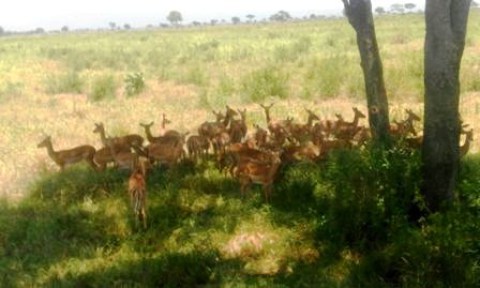 Sacred Grooves
Sacred Grooves
In Ghana Sacred Grooves comprise of objects such as a tree, stone or rock or body of water that houses a deity and its immediate surrounding which together constitute a protected area. They provide various socio-cultural and ecosystem services to local communities and their inhabitants.
| Release date | 04/09/2010 |
|---|---|
| Contributor | Kwesi Anderson |
 Sacred groves are natural areas that have been set aside and strictly protected by customary laws for social and religious reasons. The basis for the establishment of sacred groves is varied and several categories of groves exist in Ghana. Many are small and often comprising an object such a tree, stone or rock or body of water that houses a deity and it’s immediate surrounding which together constitute a shrine. Some sites are burial grounds of traditional rulers, or the former location of a village or the site of an important event, and therefore are thought to be the domain of ancestral spirits (Dorm-Adzobu, Ampadu-Agyei, & Veit 1991, Ntiamoa-Baidu et al., 1992, Dwomoh, 1990). Sacred groves are very common in Ghana and exit in almost every rural community (Blench, 2004). In all types of sacred groves some level of restriction is placed on who can enter the grove, and on extractive uses of forest resources. Hunting and collection of wood for fuel or other purposes are prohibited in most cases. The restrictions on access and use are enforced by a fear of the supernatural (ancestral spirits etc) and by community pressure to respect the customs governing the sacred grove. Sacred groves provide various socio-cultural and ecosystem services to the local communities even though the ecological benefits have not always been consciously acknowledged. In many cases a critical portion of a local watershed, such as a spring or the headwaters of a river, are protected by a sacred site, ensuring a source of clean water for the surrounding communities. With widespread deforestation and environmental degradation, leading to extensive loss of original vegetation cover, sacred groves have become important biodiversity sites in many communities in Ghana, existing as the last remnant of forest and serving as sanctuaries and refugia for native plants and animals species. Several sacred groves including Boaben-Fiema and Tafi have now been designated as Wildlife Sanctuaries (Dorm-Adzobu, Ampadu-Agyei & Veit 1991) and these are critically important for the protection of a population of about four species of monkeys and other animal and rare plant species. In recent times conservationists and local people alike have recognized just how important sacred groves and their ecological functions are to the local ecosystems and are initiating cooperative efforts to study and reinforce systems of local protection of resources. This notwithstanding, some sacred groves are being encroached upon in some communities with the increasing demand for space and resources.
Sacred groves are natural areas that have been set aside and strictly protected by customary laws for social and religious reasons. The basis for the establishment of sacred groves is varied and several categories of groves exist in Ghana. Many are small and often comprising an object such a tree, stone or rock or body of water that houses a deity and it’s immediate surrounding which together constitute a shrine. Some sites are burial grounds of traditional rulers, or the former location of a village or the site of an important event, and therefore are thought to be the domain of ancestral spirits (Dorm-Adzobu, Ampadu-Agyei, & Veit 1991, Ntiamoa-Baidu et al., 1992, Dwomoh, 1990). Sacred groves are very common in Ghana and exit in almost every rural community (Blench, 2004). In all types of sacred groves some level of restriction is placed on who can enter the grove, and on extractive uses of forest resources. Hunting and collection of wood for fuel or other purposes are prohibited in most cases. The restrictions on access and use are enforced by a fear of the supernatural (ancestral spirits etc) and by community pressure to respect the customs governing the sacred grove. Sacred groves provide various socio-cultural and ecosystem services to the local communities even though the ecological benefits have not always been consciously acknowledged. In many cases a critical portion of a local watershed, such as a spring or the headwaters of a river, are protected by a sacred site, ensuring a source of clean water for the surrounding communities. With widespread deforestation and environmental degradation, leading to extensive loss of original vegetation cover, sacred groves have become important biodiversity sites in many communities in Ghana, existing as the last remnant of forest and serving as sanctuaries and refugia for native plants and animals species. Several sacred groves including Boaben-Fiema and Tafi have now been designated as Wildlife Sanctuaries (Dorm-Adzobu, Ampadu-Agyei & Veit 1991) and these are critically important for the protection of a population of about four species of monkeys and other animal and rare plant species. In recent times conservationists and local people alike have recognized just how important sacred groves and their ecological functions are to the local ecosystems and are initiating cooperative efforts to study and reinforce systems of local protection of resources. This notwithstanding, some sacred groves are being encroached upon in some communities with the increasing demand for space and resources.
Login to add a comment
